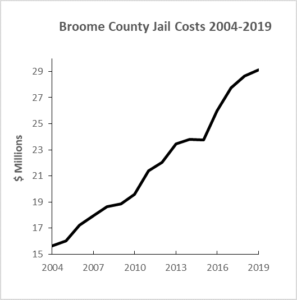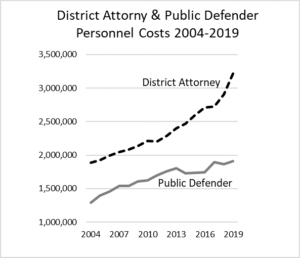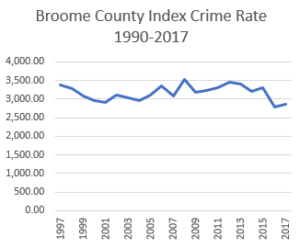The new year brings a new budget for Broome County, with the County Executive and Legislators celebrating a tax cut. As noted in a previous column here, the proposed budget projected more funding for incarceration. The approved budget reveals even more emphasis increasing funding for the prosecution, policing, and incarceration of the people, especially the poor people, of the county.
Elected officials blame the most dramatic increases on implementing Raise-the-Age, the state-imposed mandate to remove 16- and 17-year-olds from adult county jails. This indeed another “reform” that has inflated carceral costs around the state. Yet the state is, we are told, to repay related expenses. And one might have expected a reduction in local county jail costs given the removal of youth and their special needs. That hasn’t happened. Indeed the county’s new budget reveals the continuing acceleration of the practices of mass incarceration well beyond the forces targeted at youth and particularly Black and Latinx youth.
It presents a puzzle. One might ask, as did a Cortland county legislator in a public meeting there late last year:
‘Why are our county jail costs rising without end, when our county’s population is steady or falling over time and crime rates are falling?’
This is certainly the case in Broome county, where crime rates are now lower than twenty years ago, the population is smaller,[1] and yet jail funding has starkly, radically, risen[2]:

The number of correctional officers has risen from 167 to 194 over this time. This year’s budget continues the trend, bringing us four new correction officers and two new staff for the Sheriff, and five new staff for the probation office as well.
Who is losing funding? The budget eliminates, among other cuts, six public health lines, including two nurses; four nurses at Willow Point nursing home; and one part-time veterans service assistant. The county mental health division, having seen its budget cut by over 70% in the last fifteen years, and down to just 3 positions, is simply reported to have “requested a 1.3% cut in County Support.”[3]
Both Republican and Democratic legislators have continued to vote for these priorities: the continual expansion of policing and incarceration, and continual cuts in public health and public social services.
The long-term push for incarceration is even evident within the county’s criminal justice system. While the number positions in the district attorney’s office has grown from 27 to 38 in the last fifteen years, the number in the public defender’s office has remained flat at 21. Expenditures by both departments chart a startlingly enhancement of the resources and power of the DA’s office:

Is it any surprise that that those lingering unconvicted in the Broome County jail constantly complain about lack of access to harried public defenders? Or that given such allocations, Broome County has literally unparalleled resources to find and prosecute even the most minor of misdemeanors, giving us the dubious honor of having the highest incarceration of all 62 counties in the state?
Almost all these changes are reported week after week as part of frugal budgeting, bewildering attempts to make sense of what is going on in the county. Take this past week’s announcement that a new state requirement, which requires defendants to have representation at their arraignment, would be implemented by having central arraignment at the Broome County Jail. This was heralded by all our elected officials as a masterpiece of fiscal efficiency:
- Assemblywoman Lupardo: “This change will streamline the process, saving taxpayers money,”
- Senator Akshar: “Our residents deserve to have their hard-earned tax dollars spent efficiently by their local government,”
- County Executive Jason Garner: “We have a plan which not only will result in taxpayer savings but at the same time allow law enforcement to be out on the roads protecting the people,[4]
- Sherriff David Harder: “This is going to save a lot of manpower.”[5]
And where do these savings come from? They reportedly result from avoiding the cost of hiring four additional public defenders to represent persons at courts spread out around the county. Yet as local TV station WBGH reports, the sheriff has been allocated five new officers for central arraignment at the jail. Are that many needed for but two arraignment sessions a day? Can anyone do the math? Sheriff’s Officers reportedly average $72,000 or so in pay. PDs reportedly average $77,000 or so. Four PDs, who might have actually helped defendants, are certainly cheaper than five new correctional officers. And what happened to the savings from not having officers transport persons?
What the future will bring is suggested in the County Executive’s proposed Capital Improvements Program for 2019-2024: another $3 million for the Sheriff’s complex, including $700,000 for a garage next year.
It is hard to see any savings, much less a move away from decades of massively expensive over-incarceration.
References
[1] Population has fallen from 200,000 to 194,000, and while crime rates have fluctuated up and down, a downward trend is visible:

Source: New York State, Open Data, data.ny.gov, “Index Crimes by County and Agency: Beginning 1990,” https://data.ny.gov/Public-Safety/Index-Crimes-by-County-and-Agency-Beginning-1990/ca8h-8gjq
[2] Data on county budget lines are taken from annual, passed budgets posted online. Assistance from George Staudter on setting up initial budget figures is greatly acknowledged.
[3] Broome County Budget, Adopted 2019, 11/15/2018, p. 235.
[4] Lupardo, Akshar, and Garner statements from Assemblywomen Donna Lupardo website, “New law allows central arraignments at Broome County Jail, January 10, 2019.
[5] WICZ, “Broome County Is Now Central Location For Arraigning Defendants,” January 10, 2019.
0 Comments
1 Pingback